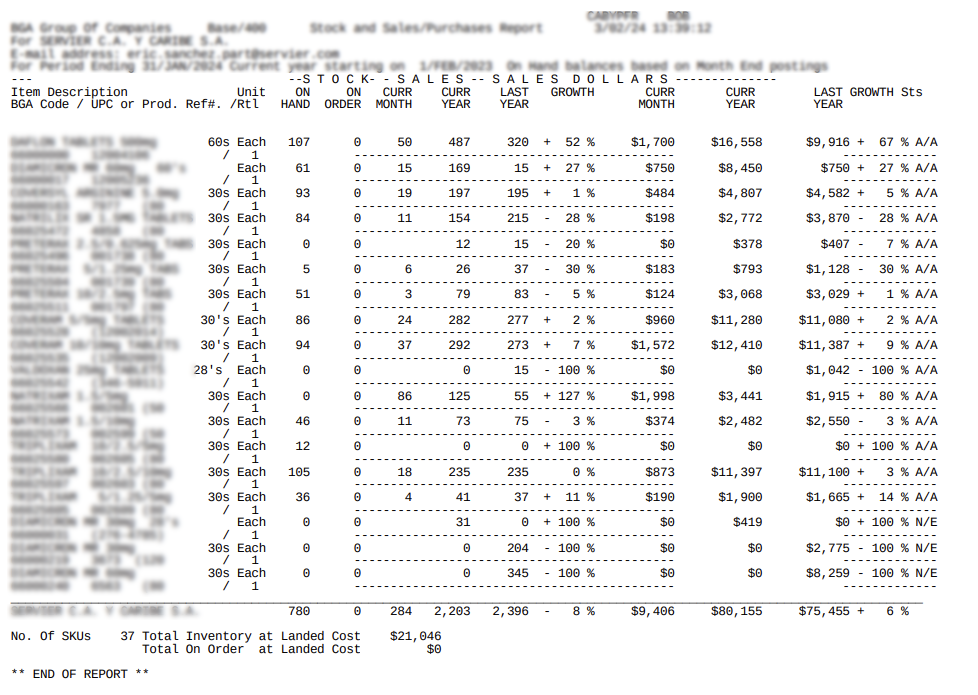Tutorial 7 - Data extraction from PDF
This tutoral is a continuation of the Tutorial 6.
This tutorial will demonstrate how to use Any2Json to extract data from one PDF. The document is not well-formed and very noisy. To demonstrate the usage of this framework, we will load a document with a somewhat complex layout, as seen here:

Setup Any2Json
Import the packages and setup the main class:
package com.github.romualdrousseau.any2json.examples;
import java.util.EnumSet;
import java.util.List;
import com.github.romualdrousseau.any2json.Document;
import com.github.romualdrousseau.any2json.DocumentFactory;
import com.github.romualdrousseau.any2json.parser.LayexTableParser;
public class Tutorial7 implements Runnable {
public Tutorial7() {
}
@Override
public void run() {
// Code will come here
}
public static void main(final String[] args) {
new Tutorial7().run();
}
}
pom.xml
Any2Json has a very modular design where each functionality can be loaded separatly. We add the "any2json-net-classifier" module to enable the tagging capabilities. This module use TensorFlow for Java. The following depedencies are required to run the code of this tutorial:
<!-- ShuJu Framework -->
<dependency>
<groupId>com.github.romualdrousseau</groupId>
<artifactId>shuju</artifactId>
<version>${shuju.version}</version>
</dependency>
<dependency>
<groupId>com.github.romualdrousseau</groupId>
<artifactId>shuju-jackson</artifactId>
<version>${shuju.version}</version>
</dependency>
<!-- Any2Json Framework -->
<dependency>
<groupId>com.github.romualdrousseau</groupId>
<artifactId>any2json</artifactId>
<version>${any2json.version}</version>
</dependency>
<dependency>
<groupId>com.github.romualdrousseau</groupId>
<artifactId>any2json-layex-parser</artifactId>
<version>${any2json.version}</version>
</dependency>
<dependency>
<groupId>com.github.romualdrousseau</groupId>
<artifactId>any2json-net-classifier</artifactId>
<version>${any2json.version}</version>
</dependency>
<dependency>
<groupId>com.github.romualdrousseau</groupId>
<artifactId>any2json-csv</artifactId>
<version>${any2json.version}</version>
</dependency>
<dependency>
<groupId>com.github.romualdrousseau</groupId>
<artifactId>any2json-excel</artifactId>
<version>${any2json.version}</version>
</dependency>
<dependency>
<groupId>com.github.romualdrousseau</groupId>
<artifactId>any2json-pdf</artifactId>
<version>${any2json.version}</version>
</dependency>
Load base model
To parse a document, any2Json needs a model that will contains the parameters required to the parsing. Instead to start from an empty Model (See Tutorial 8), we will start from an existing one and we will adapt it for our document. You can find a list and details of all models here.
The base model, we will use, is "sales-english" that has been trained on 200+ english documents containing distributor data and with a large range of different layouts.
The base model already recognize some entities such as DATE and NUMBER. We will configure a layex to extract the different elements of the documents. You can find more details about layex here.
final var model = Common.loadModelFromGitHub("sales-english");
// Add a layex to the model
final var tableParser = new LayexTableParser(
List.of("(v.$)+"),
List.of("(()(v.+$v.+$))(()(e.+$)+())(v.+$)"));
model.registerTableParser(tableParser);
Load the document
We load the document by creating a document instance with the model. The hint "Document.Hint.INTELLI_LAYOUT" tells the document instance that the document has a complex layout. WThe recipe "sheet.setCapillarityThreshold(0)" tells the parser engine to extract the features as small as possible:
final var file = Common.loadData("document with noises.pdf", this.getClass());
try (final var doc = DocumentFactory.createInstance(file, "UTF-8")
.setModel(model)
.setHints(EnumSet.of(Document.Hint.INTELLI_LAYOUT))
.setRecipe(
"sheet.setCapillarityThreshold(0)",
"sheet.dropNullRows(0.45)")) {
...
}
Output the tabular result
Finally, we iterate over the sheets, rows and cells and output the data on the console:
doc.sheets().forEach(s -> Common.addSheetDebugger(s).getTable().ifPresent(t -> {
Common.printHeaders(t.headers());
Common.printRows(t.rows());
}));
2024-03-13 17:56:46 INFO Common:43 - Loaded model: sales-english
2024-03-13 17:56:46 INFO Common:60 - Loaded resource: /data/document with noises.pdf
2024-03-13 17:56:49 DEBUG Common:87 - Extracting features ...
2024-03-13 17:56:49 DEBUG Common:91 - Generating Layout Graph ...
2024-03-13 17:56:49 DEBUG Common:95 - Assembling Tabular Output ...
============================== DUMP GRAPH ===============================
document with noises
|- Item DescriptionUnit BGA Code / UPC or Prod. Ref#. /Rtl ON HAND ORDER MONTH ONCURRCURRLAST YEARYEAR GROWTHCURR MONTH CURRLAST GROWTH Sts YEARYEAR DATA(0, 0, 6, 20, 21, 18) (1)
================================== END ==================================
2024-03-13 17:56:49 DEBUG Common:100 - Done.
Item Description ON HAND ORDER MO ONCURRCURRLAST Y GROWTHCURR MONTH CURRLAST GROWTH
XXXXXX XXXXXXX X 107 050487320 + 52 % $1,700 $16,558$9,916 +
XXXXXXXXX XX XXm 61 01516915 + 27 % $750 $8,450$750 + 27
XXXXXXXX XXXXXXX 93 019197195 + 1 %$484 $4,807$4,582 +5
XXXXXXXX XX XXXM 84 011154215 - 28 % $198 $2,772$3,870 - 2
XXXXXXXX XXX/XXX 0 01215 - 20 % $0 $378$407 -7 % A/
XXXXXXXX X/XXXXX 5 062637 - 30 % $183 $793$1,128 - 30
XXXXXXXX XX/XXXX 51 037983 - 5 %$124 $3,068$3,029 +1
XXXXXXX X/XXXXXX 86 024282277 + 2 %$960 $11,280$11,080 +
XXXXXXX XX/XXXX 94 037292273 + 7 %$1,572 $12,410$11,387 +
XXXXXXXX XXXX XX 0 0015 - 100 % $0 $0$1,042 - 100 %
XXXXXXXX XXX/XXX 0 08612555 + 127 % $1,998 $3,441$1,915 + 8
XXXXXXXX XXX/XXX 46 0117375 - 3 %$374 $2,482$2,550 -3
XXXXXXXXX XX/XXX 12 000 + 100 % $0 $0$0 + 100 % A/A
XXXXXXXXX XX/XXX 105 018235235 0 %$873 $11,397$11,100 +
XXXXXXXXXXXXXXXX 36 044137 + 11 % $190 $1,900$1,665 + 1
XXXXXXXXX XX XXX 0 0310 + 100 % $0 $419$0 + 100 % N
XXXXXXXXX XX XXX 0 00204 - 100 % $0 $0$2,775 - 100 %
XXXXXXXXX XX XXX 0 00345 - 100 % $0 $0$8,259 - 100 %
On this output, we print out the graph of the document built during the parsing and we can see clearly the relation between the elements of the spreadsheet and how there are structured in tabular form.
Conclusion
Congratulations! You have loaded documents using Any2Json.
For more examples of using Any2Json, check out the tutorials.